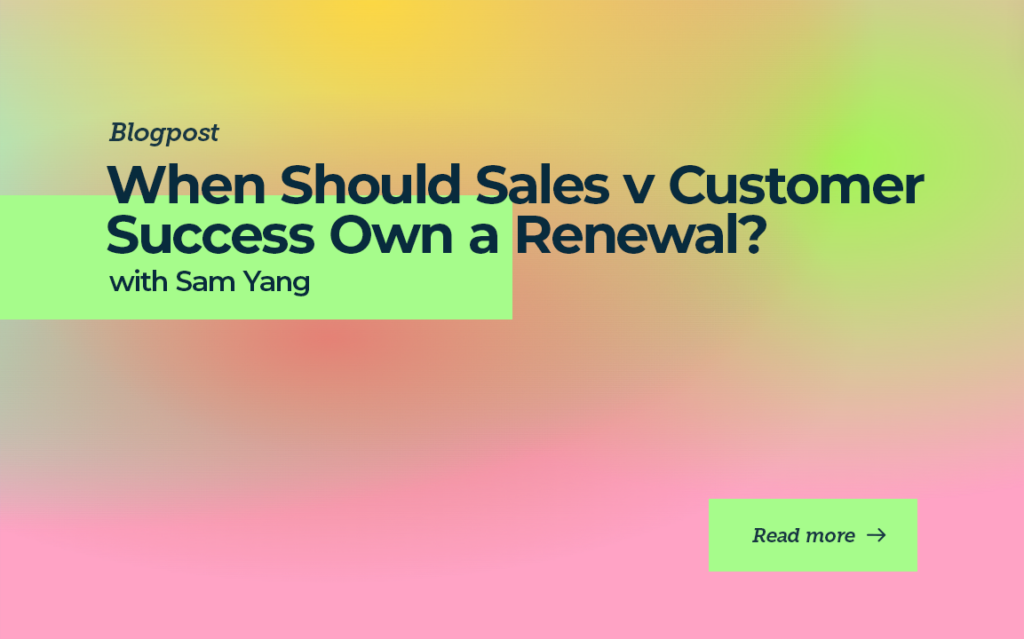When Should Sales vs Customer Success Own a Renewal with Sam Yang

Welcome to another episode of the Predictable Revenue Podcast, where we’re unpacking a riveting conversation from our show. This time, we enjoyed hosting Sam Yang, President of Field Operations at People.ai.
Our discussion centered on the complex relationship between Customer Success and Sales, specifically, who should own the deal and when. If you’re an Account Executive, a revenue leader, or involved in renewals and upsells, this post will offer valuable insights.
The Intricacies of Sales and Customer Success
Sam Yang draws an interesting parallel between Sales and Customer Success teams and a football game. In his view, the Sales team acts as the offense, aggressively pushing to score and put points on the board.
Meanwhile, the Customer Success team serves as the defense focused on protecting the base and ensuring customer satisfaction.
Leadership and Organizational Structure
The leadership overseeing these two crucial teams can vary from organization to organization. Sometimes, it’s the CEO, the President, or even the Chief Revenue Officer. But regardless of who’s at the helm, the ultimate goal is for both teams to work harmoniously for collective success.
Sam emphasizes the need for clear rules of engagement between Sales and Customer Success. These rules help define when each team should lead, especially in renewals or upsell scenarios.
Navigating the Renewal Maze – Sales or Customer Success?
Sam Yang compares the decision of who should own the renewal to the role of special teams in football. Depending on the situation, these teams can be used offensively or defensively.
Similarly, the ownership of renewals can be flexible, shifting between Sales and Customer Success based on the company’s strategic objectives.
The KPI Compass: Gross Revenue Retention (GRR)
Sam Yang offers a straightforward, KPI-driven approach regarding who should own the renewal process, Sales, or Customer Success. He zeroes in on GRR as the compass to guide this critical decision.
Here’s how it works:
- GRR Above 95%: If your company boasts a GRR above 95%, it’s a green light for Customer Success to take the reins on renewals. This high GRR indicates a strong customer retention rate, allowing Sales to channel their energy into acquiring new business.
- GRR Between 90-95%: This is the yellow zone, a cautionary area that calls for a nuanced approach. Here, the decision could go either way and should be evaluated case by case.
- GRR Below 90%: If you find yourself in this red zone, it’s a signal that Sales should step in. A GRR below 90% suggests renewals require more than administrative work; they need a sales-driven strategy to prove value and secure customer commitment.
By using GRR as your guiding metric, you can make informed, strategic decisions about who should own the renewal process, optimizing customer retention and new business acquisition.
Situational Best Practices
Sam stresses that the decision on renewal ownership should align with the company’s current stage. It’s not merely about the deal but the company’s growth journey. This situational approach allows for flexibility and adaptability in renewal strategies.
The Renewal Playbook – Tactical Insights
The type of product you offer also influences who should own the renewal. For instance, if your product is hard to replace and has high retention, like Slack, Customer Success might be best suited to manage the renewal.
However, sales would likely be more effective for complex products like Salesforce, where upselling and bundling are common.
The Importance of Flexibility
One of the key takeaways from the conversation with Sam is the need for flexibility in determining who owns the renewal. It’s not a one-size-fits-all answer but a strategic decision that should be revisited periodically to align with the company’s goals and performance metrics.
Intricacies of Product Type in Renewals
Sam Yang elaborates on how the type of product licensing can significantly influence renewals. In user-based licensing, high active usage rates (70-90%) strongly indicate that Customer Success can handle the renewal. However, if only 10-30% of licenses are actively used, it’s a red flag.
Sales needs to step in to prevent down-sells or churn by re-emphasizing the product’s value.
On the other hand, the team’s expertise in renewals becomes crucial for consumption-based products, where revenue directly correlates with usage. If your Customer Success team has the necessary commercial experience, they can take the lead. Otherwise, Sales should handle it.
The Renewal Dilemma: Skill Set Over Team
Sam emphasizes that the skill set of your Customer Success team can be a game-changer. If they have commercial experience and negotiation skills, they are well-equipped to handle renewals. However, if they are more of a support team, Sales should take the lead.

Blurred Lines Between Customer Success and Account Management
Key Points:
- Traditional Roles: Account managers in Sales used to handle renewals and customer management.
- Modern Shift: Today’s Customer Success roles are more solutions-aware and versatile, making them well-suited for renewals if they have the necessary commercial experience.
- Skill Set Focus: The emphasis should be on the skill set rather than the team name or title. The team with the required commercial acumen should handle renewals.
- Adaptability: The landscape of customer management is ever-changing. Being adaptable and aligning skill sets with responsibilities is crucial.
Q&A Highlights
- What has changed in the role of account managers?
The role has evolved to include more responsibilities, often shifting to the Customer Success team.
- What should companies focus on for effective renewals?
Companies should focus on the skill set required for renewals rather than the specific team that handles them.
- Why is adaptability important?
As roles and responsibilities evolve, adapting is crucial for effective customer management and successful renewals.
Complex Renewal Scenarios: A Case Study Approach
The Scenario
Imagine you’re an Account Executive faced with a challenging renewal situation: Your customer has a $100k deal but only $20k worth of active users. What do you do?
Sam Yang’s Approach
Sam Yang suggests a multi-faceted approach to tackle this complex issue:
- Prevention Over Cure: The first step is to avoid landing in such a situation. This involves evaluating the initial sales process, implementation, and onboarding.
- Mission-Critical or Nice-to-Have: Assess whether your product is mission-critical to the customer’s business. If it’s just a ‘nice-to-have,’ you’re at a higher risk of churn.
- Relationships Matter: The strength of your relationship with the customer’s economic buyer and champions can significantly influence the renewal outcome.
Possible Outcomes
Based on these factors, Sam outlines three potential outcomes:
- Let Them Churn: If the product isn’t mission-critical and you lack strong relationships, letting the customer churn might be the best option.
- Downsize to $20k: If the customer still sees some value but not enough to justify the total price, downsizing the deal might be a win-win.
- Full Renewal: Aim for a complete renewal if you have solid relationships and the product is mission-critical.
Additional Insights
- Root Cause Analysis: Understand why the customer’s usage is low by examining the entire customer journey, from the initial sale to ongoing use.
- Shared Accountability: Both the sales and customer success teams share responsibility for the customer’s usage level. The focus should be on identifying the root issue and fixing it to prevent similar situations in the future.
The Role of the Product: If the product is challenging to adopt or doesn’t integrate well into the customer’s day-to-day operations, it could lead to low usage and, ultimately, churn.
The Art of Weekly Monitoring
The Mission-Critical Spectrum: Not all products are created equal. While some are indispensable, like CRMs and email services, others, like LinkedIn Sales Navigator, are essential but not mission-critical. Then there are the ‘nice-to-haves’ good products that aren’t vital for business continuity.
Why This Matters: The Customer Success team often has the task of elevating a ‘nice-to-have’ product to ‘mission-critical’ status. This focus should not be diluted, especially when renewals are on the line.
Utilization Metrics: Tracking product utilization isn’t a quarterly or annual event. It’s a weekly ritual. Sam Yang insists that CSMs and AEs sync with their ops teams to monitor metrics like Monthly Active Users (MAU) or Weekly Active Users (WAU).
The Engagement Factor: In a SaaS world, engagement isn’t a luxury; it’s a necessity. If you’re not keeping users engaged, you’re risking churn and throwing upsell opportunities out the window.
The Solo AE’s Guide to Upsells and Product Usage
Sam Yang offers actionable advice for these solo AEs, emphasizing the importance of monthly check-ins and consistent usage tracking.
For AEs focused solely on new business, Sam suggests applying similar principles to warm up accounts. Driving consistent usage among active users can be a prelude to a successful upsell if your business model includes a free service.
Moreover, these principles aren’t just limited to your product; they can also extend to your content strategy. For instance, if you host monthly webinars, aim to increase attendance among your prospects. This consistent engagement can serve as a foundation for future upsells.
For full-cycle salespeople who juggle multiple roles, the critical takeaway is scalability. You may not be able to do everything a specialized Customer Success team can, but you can scale these best practices to fit within your bandwidth and responsibilities.

The Economics of Customer Retention and Upselling
Sam dives deep into the economics of customer retention and upselling, offering a nuanced understanding that goes beyond surface-level metrics. He introduces the concept of “Theoretical TAM vs. Actual SAM,” emphasizing that while your total addressable market might be vast, your serviceable available market and what you can realistically sell in the short term matter.
Moving on, he talks about the importance of customer life expectancy in calculating LTV. He explains that improving churn rates can significantly extend a customer’s life expectancy, positively affecting the LTV. This is crucial for any sales or customer success team focused on long-term growth.
But Sam doesn’t stop there. He warns about the direct correlation between ASP and churn. If you’re increasing your ASP, you must be cautious about how it might affect your churn rates. An imbalance here can nullify any gains in LTV, making your growth strategies ineffective.
Balancing Price Increases and Customer Value
Imagine you’re a long-time customer of a software service. The price creeps up yearly, but you don’t see any added value. Frustrating, isn’t it? This is a common scenario that many customers face, and it’s a dangerous game for companies to play.
- The Dilemma: Companies are under pressure to grow, especially in the fast-paced startup community. But how do they do it without alienating their customer base?
- The Rule of Thumb: If you raise your price by 10%, ensure the customer feels they’re getting 20% more value. It’s not just about numbers; it’s about perception.
Questions to Ponder:
- Are you providing enough value to justify a price increase?
- Could you be risking long-term customer relationships for short-term gains?
The Reality Check: The startup community has grown rapidly over the past seven to eight years, fueled by abundant funding. This growth has put immense pressure on companies to keep scaling, sometimes leading to unwarranted price increases.
The Double-Edged Sword: Companies often justify price hikes by claiming to add new features or services. But what if the customer doesn’t find these additions valuable? You risk losing a loyal customer, as with a vendor who almost doubled their prices over five to six years without adding perceivable value.
The Final Word: If you’re considering a price hike, you better be sure you’re offering significantly more value. Otherwise, you risk losing customers and damaging your brand’s reputation. In the end, everyone loses in this scenario.
Deposits and Withdrawals in Customer Relationships
The complex world of customer relationships often feels like a financial transaction. You make “deposits” by delivering value and “withdrawals” when asking for something in return, like a price increase.
The balance between these deposits and withdrawals is crucial for maintaining a healthy relationship.
In cases where your customer landscape changes, perhaps your internal champion leaves, or the business unit you were working with is no longer there, you’re dealing with what’s known as “Red” or “Dead” accounts. These require a different approach, almost like treating them as new business prospects. This is where your BDR and SDR teams can be invaluable. They are skilled in initiating new conversations and can help you navigate these tricky waters.
The Cohort Analysis
This data-driven tool can show you how each customer group behaves over time. For example, if a cohort stabilizes six quarters in, it strongly indicates that locking in a two-year deal is beneficial. This insight lets you decide how much ASP you will sacrifice for longer-term stability.
Moreover, the Cohort Analysis isn’t just a one-size-fits-all tool. It can be sliced and diced by various factors like verticals, markets, and geographical regions. This level of detail can guide your multi-year strategy, helping you decide the importance of two and three-year deals versus one-year deals.
Contract Renewals and Customer Retention
Regarding renewals, the contract and the product are both players on the field, but they don’t consistently score goals similarly. If your retention rates dip after the first year, but you’ve locked a customer into a three-year contract, that contract is doing the heavy lifting. It’s holding the relationship together but also adding tension.
On the flip side, if your accounts generally grow, locking into a long-term revenue deal might not be necessary.
So, what’s the strategy? Data-driven decision-making is vital.
Cohort analysis can reveal valuable insights. If, after 12 months, your revenue from a particular cohort has grown from 100% to 120%, you’re in a good place—no need for multi-year contracts. But if only 20-30% of your licenses are being used, you will likely see a decrease in AR after the first year. In such cases, multi-year contracts can act as a safety net, even if it means sacrificing some average selling price.
But it’s not a one-size-fits-all approach. Different customer segments behave differently. Power users and casual users will have different retention and growth patterns. Even geographical markets matter. In some countries, multi-year deals are risky due to higher chances of bad debt in subsequent years.
And what if a customer turns into bad debt?
Well, the approach varies. If the customer genuinely struggles, you might have to write it off or send it to collections. But if they’re deliberately defaulting, it’s a different ball game. Sometimes, renegotiation works; occasionally, you cannot send them to collections.
Discipline in Revenue Recognition
Recognize incremental revenue year-on-year rather than averaging it out. This tees you up for growth and gives you an upsell cushion.
Sales teams often maximize budgets by over-provisioning licenses. This can backfire. The smarter move? Offer fewer licenses but make them flexible. This safeguards your GRR and creates upsell opportunities, boosting your NRR.
But what about delivering value faster to the customer?
Cutting down implementation time increases user adoption. This, in turn, opens up more upsell avenues. It’s not just about sales; customer success teams play a crucial role here. They can be passionate about driving more adoption, even for products that aren’t naturally viral.
Different markets also have different dynamics. In some international markets, the risk of bad debt in years two and three is too high to consider multi-year deals. In such cases, thinking twice before offering discounts for multi-year commitments is better.
And what if a company turns into bad debt? You might have to let it go or send it to collections if it’s a genuine struggle. But if they can pay and choose not to, that’s a different ball game. Renegotiation might work, but sometimes, you cannot send them to collections.
Conclusion
Sam Yang’s insights offer a deep dive into the intricacies of customer retention and renewals, drawing parallels between Sales and Customer Success teams and a football game. He stresses the importance of clear rules of engagement and flexibility in determining who owns the renewal process. Using Gross Revenue Retention (GRR) as a guiding metric, Sam provides a nuanced approach to making this critical decision.
He also highlights the importance of adaptability, emphasizing that renewal strategies should align with a company’s growth stage and the type of product offered. The skill set of your Customer Success team can be a game-changer, and the focus should be on commercial acumen rather than team titles.
Sam doesn’t stop at renewals; he delves into customer retention and upselling economics, cautioning against unwarranted price increases that could alienate customers. He advocates for a balanced approach, where value delivery and price increases go hand in hand.
NO TIME TO READ?
Listen On:



